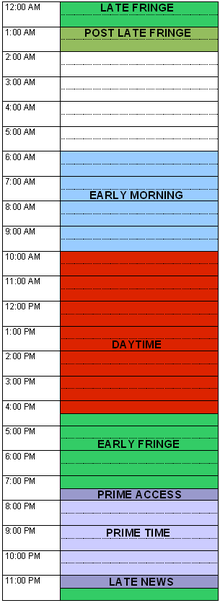Late-night television

Late night television in television broadcast programming is dayparting. It follows prime time and precedes the overnight television programming graveyard slot. The slot generally runs from about 11:00 PM. to 2:00 AM local time, with variations according to the time zone.
In the United States and Canada, however, the term "late night" is synonymous with the late-night talk show, a type of comedic talk and variety show. Thus, the late night programming block is considered more important in North America.[1] On most major-network stations, a late local newscast airs at the beginning of the block. (This is nearly universal in Canada, as late local news is an easy way to fulfill Canadian content requirements.)
In the United Kingdom, the late night spot is from 11:00 PM to 12:30 AM and not seen as a priority; ITV and Channel 4 program repeats in the time slot, and the BBC's channels primarily show BBC World News, air movies or replay documentaries.[2] Similarly, Australian television primarily airs American late shows, lower-priority imported series or overflows of sports programming in the late night time slot.
On cable television, programming strategies in this time slot include timeshifts of prime time programs and, in the case of children's television channels, signing-off and allowing more adult-oriented fare for the overnight hours under another brand. An example is the children's channel Nickelodeon, which changes over to Nick at Nite at an hour when most pre-adolescent children go to sleep. Nick at Nite typically airs series programming, such as reruns of sitcoms, that may have coarser language and more adult themes.[3]
Japan's late night programming is reserved for late night anime, which targets older audiences.[4] This is also true of the North American-based cable channel Cartoon Network, which targets children and young teens during daytime and primetime hours, but changes over to its Adult Swim brand in late-night slots.[5]
See also
- Late-night news
- Late-night talk show
- Late night television in the United States
- List of late-night American network TV programs
References
- ^ http://news.bbc.co.uk/2/hi/8450575.stm "This diet of TV late at night is a key reason up to 40% of Americans get less than the 'recommended' seven to eight hours of sleep, according to recent research from the University of Pennsylvania."
- ^ Why do Americans care about late night TV? Elizabeth Diffin and Megan Lane at news.bbc.co.uk
- ^ Collins, Scott (2004-03-25). "Nickelodeon Squeezes 2 Ratings Out of 1 Very Diverse Network — Los Angeles Times". Articles.latimes.com. Retrieved 2012-10-24.
- ^ Why does most anime in Japan air late-night? at animenewsnetwork.com
- ^ Adult Swim/CN Split Cements Strategy. ICv2. March 3, 2005.
